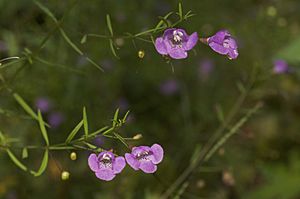Common gerardia facts for kids
Quick facts for kids Common gerardia |
|
|---|---|
 |
|
| Scientific classification | |
| Genus: |
Agalinis
|
| Species: |
tenuifolia
|
| Synonyms | |
Agalinis tenuifolia, also called the common gerardia or slender false foxglove, is a wild plant. It grows every year, meaning it's an annual plant. This plant is native to parts of the eastern and southwestern United States, and Canada. It is known for its pretty purple flowers that bloom in late summer or early fall.
Contents
What Does Agalinis tenuifolia Look Like?
The Agalinis tenuifolia plant usually grows to be about 20 to 60 centimeters (8 to 24 inches) tall. It has a thin stem with many branches. Its leaves are simple and grow opposite each other on the stem. Each leaf is about 20 to 50 millimeters (0.8 to 2 inches) long and very narrow, only 1 to 3.5 millimeters (0.04 to 0.14 inches) wide.
The flowers of this plant grow on small stems called pedicels, which are 10 to 20 millimeters (0.4 to 0.8 inches) long. Each flower has a special shape, with five petals that are joined together. These petals are about 10 to 15 millimeters (0.4 to 0.6 inches) long and are usually purple. Inside the flower, there are four stamens, which are the parts that make pollen.
After the flower blooms, it forms a round, dry fruit called a capsule. This capsule is about 3 to 7 millimeters (0.12 to 0.28 inches) long. When it is ripe, it splits open to release its seeds.
Where Does Agalinis tenuifolia Grow?
Agalinis tenuifolia is found across a large area in the eastern United States and Canada. It grows in many states, from Alabama to Wyoming. It is also found in Canadian provinces like Manitoba and Quebec.
This plant needs the right kind of place to grow. In some areas, like Virginia, it likes dry woods and open, disturbed spots, such as old fields. However, in places like Michigan, it can grow in moist or even marshy ground, including river banks.
Sometimes, this plant can disappear from an area. This might happen because of new buildings, changes in how land is used, or when invasive species (plants that don't belong there) take over its habitat. In Rhode Island, Agalinis tenuifolia is considered a species of special concern. This means people are watching it closely to make sure its populations stay healthy.
How Does Agalinis tenuifolia Get Food?
Like other plants in its group, Agalinis tenuifolia is a hemiparasitic plant. This means it's a bit like a gentle "plant vampire"! It connects its roots to the roots of other plants, especially grasses and similar plants. It uses special parts called haustoria to do this. Through these connections, it can take some water and nutrients from its host plants.
Even though it gets some help from other plants, Agalinis tenuifolia also has green leaves. This means it can still make its own food through photosynthesis, just like most other plants. So, it doesn't fully rely on its hosts; it just gets a little boost!
How Scientists Classify Agalinis tenuifolia
Scientists use a system called taxonomy to group and name living things. Agalinis tenuifolia belongs to the genus Agalinis.
For a long time, this genus was placed in the plant family called Scrophulariaceae. However, based on newer scientific studies, especially from the Angiosperm Phylogeny Group, scientists have moved it. Now, Agalinis is placed in a different family called Orobanchaceae. This change helps scientists better understand how different plant groups are related to each other.


